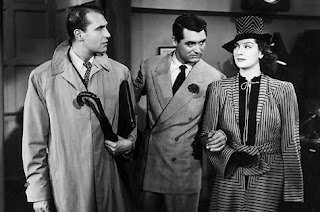James Stewart was
a war hero and maybe the most approachable celebrity. He is my first
choice in this list for his versatile acting and real-life heroic
acts.
James Stewart was born with
the middle name Maitland and was known to be a shy child. He
went to Mercersburg Prep School, which he graduated from in the year 1928. His
first play on stage was "The Wolves". He had a vast collection of toy airplanes. This later inspired him to venture aviation. He was later invited to join the University Players, with Henry Fonda, who later became his best friend.
 |
| James Stewart (1908-1997) |
His first important role was
as David Graham in the comedy-mystery film "After the Thin Man" (1936), which
put the actor in the bad guy role. Then, by 1938, he became more famous after shooting comedy films like "You Can’t Take It With You" (1938), "The Shop Around the Corner" (1940), "The Philadelphia Story" (1940) and "Pot o’ Gold" (1941).
After World War II, he came
back, made ‘It’s a Wonderful Life" (1946) with Lionel Barrymore and Donna Reed.
That was a Christmas classic, but it did not get him anywhere.
Two men, both film
directors, saved him. The first was Alfred Hitchcock, who lured him next to
Farley Granger and John Dall for "Rope" (1948), "Rear Window", "The Man Who Knew Too Much" (1956) and "Vertigo" (1958).
The other man was Anthony
Mann, who lured him into more violent westerns. Their first collaboration was "Winchester 73" (1950) with Anthony Quinn and Dan Duryea, and when Stewart knocked those
villains over the bar, it was not what the audiences had seen before.
His lessons for
us are that vitality exists, whether or not we are heroes.
Here are some of his best
films:
AFTER THE THIN MAN (BLACK
AND WHITE, 1936)
James Stewart isn't the lead, merely a side show, but this was the
one which displayed his type of roles and the type of villain he used to play
before the Mann westerns or the Hitchcock thrillers.
THE PHILADELPHIA STORY
(BLACK AND WHITE, 1940)
Director George Cukor brings
in James Stewart as cynical reporter Macaulay Connor, Liz Imbrie, played by
Ruth Hussey, is his photographer. Cary Grant and Katherine Hepburn, the two
other leads pull strings from the sole, as, respectively, C.K. Dexter Haven and
Tracy Lord, ex-marrieds who are part of the marriage plot though Tracy’s wanted
to marry John Howard’s industrialist.
My all-time favourite classic. James Stewart plays George Bailey, the best American hero
there was (and is). The supporting cast is excellent – Ward Bond, Lionel
Barrymore, Donna Reed, Henry Travers, Beulah Bondi, Frank Albertson and H.B.
Warner. This is Stewart’s arguably best role.
ROPE (COLOUR, 1948)
James Stewart stars as Rupert Cadell, the best
schoolteacher you will ever see in a movie, though his is more of a psych in
this movie confronting the two killers played by Farley Granger and John Dall.
HARVEY (BLACK AND WHITE, 1950)
Elwood P. Dowd, the lead character is played by Stewart,
like the Mary Chase play. Josephine Hull plays her sister, Peggy Dow as a
nurse, Virginia Horne as Stewart’s niece and Charles Drake as a doctor. The
invisible rabbit is unbelievable to adults while children think that it’s
half-half.
THE GREATEST SHOW ON EARTH
(COLOUR, 1952)
James Stewart is not the
lead, but stars in the movie’s most mellow role as a clown and killer. He was always
in clown make-up, other than the photograph a cop gives Charlton Heston, as he
asks whether or not he knows that man. Betty Hutton plays Holly the trapeze
artist and Gloria Grahame plays ‘Angel’.
THE MAN WHO KNEW TOO MUCH (COLOUR, 1956)
Hitchcock made a similar film of the same name in 1934, but now he decided to direct it again. This time shooting in colour, he used the same old plot. The plot takes place in Morocco, when a doctor, Benjamin (James Stewart), and his wife (Doris Day) meet a man on a bus, they get suspicious. After he is killed and their son kidnapped, the plot begins to unravel. Doris Day's song Que Sera Sera was made famous through this movie.
REAR WINDOW (COLOUR, 1954)
L.B. Jefferies was the
photographer Stewart played in this thriller from the master director Alfred Hitchcock. Look for the director’s cameo appearance – as a clock winder. Also
notice the vignettes happening in each room.
VERTIGO (COLOUR, 1958)
John Scottie Ferguson is
James Stewart’s character, an acrophobic cop who investigates why Kim Novak has been acting so strangely in front of her husband, Gavin, played by Tom Helmore.
A Hitchcock movie.
THE MAN WHO SHOT LIBERTY
VALANCE (BLACK AND WHITE, 1962)
Another of my favourite westerns. Director John Ford paired
Stewart with actor John Wayne for the first and second-last time. James Stewart
is a lawyer, now senator, who goes to the funeral of Tom Doniphan (Wayne) and
he recalls the good old days when Tom and himself were fighting for the same
girl (Vera Miles) while trying to stop Liberty Valance (Lee Marvin) from
terrorising the west.

















